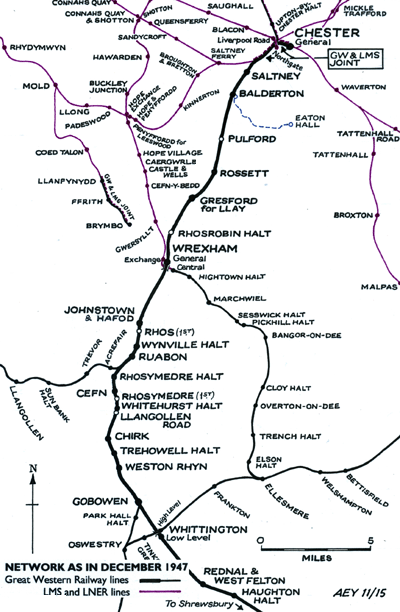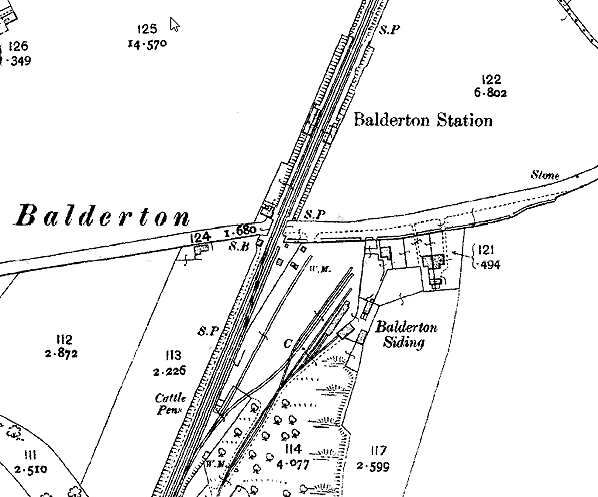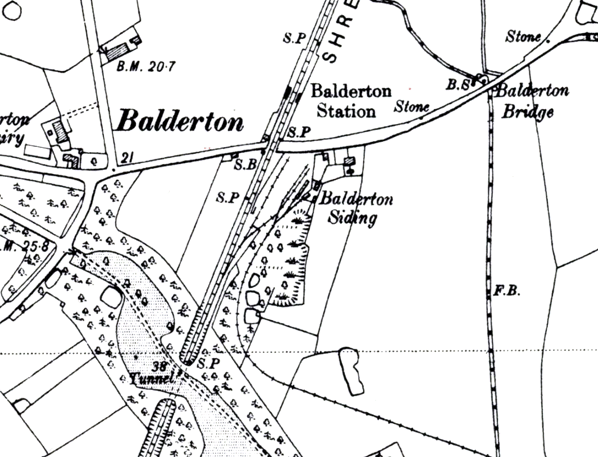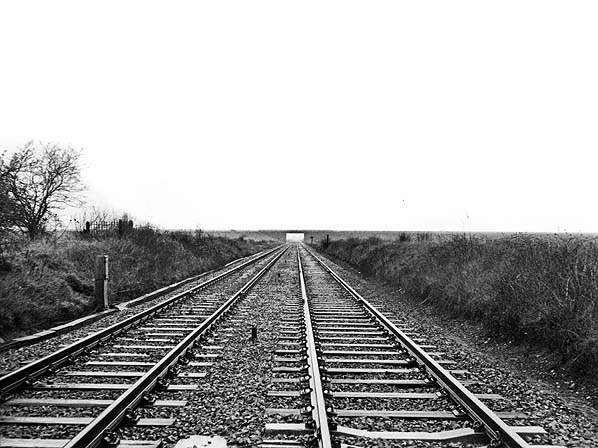|
Notes: Balderton was located on the Great Western Railway’s (GWR) main line that linked Birmingham to the River Mersey at Birkenhead via Chester. The section of line on which Balderton was situated had been opened by the Shrewsbury & Chester Railway (S&CR) on 4 November 1846. At that time it stretched only from Saltney Junction (near Chester) and a temporary station at Rhosymedre on the north side of the Vale of Llangollen. Almost two years later on 14 October 1848 the Rhosymedre to Shrewsbury section opened. The S&CR was taken over by the Great Western Railway (GWR) on 1 September 1854 (Click here to read more about the S&CR and the GWR take over) thereby creating a route to the north for that company.
 The station at Balderton was located to the east of the small settlement after which it was named on the north side of Lache Lane and it first appeared in the public timetable in 1901. There had been a siding at Balderton since the earliest days of the railway located on the south side of Lache Lane on the east side of the main line. In 1896 a narrow gauge railway had opened from the siding at Balderton to Eaton Hall the home of the Duke of Westminster. Facilities were installed for the exchange of goods from the main line to the narrow gauge railway. The 15inch gauge railway was built solely to serve the needs of the Duke of Westminster and his household. Coal and other goods were delivered to the hall by the railway. Private passenger trains were also operated on the line. The station at Balderton was located to the east of the small settlement after which it was named on the north side of Lache Lane and it first appeared in the public timetable in 1901. There had been a siding at Balderton since the earliest days of the railway located on the south side of Lache Lane on the east side of the main line. In 1896 a narrow gauge railway had opened from the siding at Balderton to Eaton Hall the home of the Duke of Westminster. Facilities were installed for the exchange of goods from the main line to the narrow gauge railway. The 15inch gauge railway was built solely to serve the needs of the Duke of Westminster and his household. Coal and other goods were delivered to the hall by the railway. Private passenger trains were also operated on the line.
Lache Lane crossed the railway via a level crossing which also provided access to the station platforms. The two flanking platforms were provided with standard ‘turn of the century’ GWR buildings: single-storey of brick construction with hipped roofs. Window openings had restrained segmental arches and tall chimneystacks reached well above the roof line. The disused station at Fawley (Herefordshire) is a fine surviving example. On the down (Chester –bound) platform was the larger building containing the booking hall, and facing it, on the Shrewsbury platform was a smaller structure providing waiting facilities. A pitched-roofed awning stretched over the platform from the larger building, its saw-tooth valance gently curved at the sides and straight at the front. The smaller building’s awning was flat, but its valance complemented that on the larger building.
On the south side of the level crossing, west of the line, was a signal box which had opened in 1898. It had a twenty-three lever frame.
Since 1 October 1861 there had been express passenger services between London Paddington and Birkenhead which used the former S&CR line but they did not routinely call at Balderton. There were however up direction direct trains to Birmingham Snow Hill, Barmouth and Shrewsbury. Being close to Eaton Hall the station was also visited by the Royal Train on a number of occasions.
In 1903 6,367 passenger tickets were issued at Balderton which was relatively few by the standards of the time. However the station handled 13,420 parcels and it received 3,315 tons of coal. General goods forwarded amounted to 109 tons and 1,109 tons were received. Livestock movements through the station amounted to 25 wagons.
 Since 1 October 1861 there had been express passenger services between London Paddington and Birkenhead which used the former S&CR line but they did not routinely call at Balderton. There were however up direction direct trains to Birmingham Snow Hill, Barmouth and Shrewsbury. Being close to Eaton Hall the station was also visited by the Royal Train on a number of occasions. Since 1 October 1861 there had been express passenger services between London Paddington and Birkenhead which used the former S&CR line but they did not routinely call at Balderton. There were however up direction direct trains to Birmingham Snow Hill, Barmouth and Shrewsbury. Being close to Eaton Hall the station was also visited by the Royal Train on a number of occasions.
The July 1922 timetable showed seven up and five down trains Monday-to-Saturday. On Sundays there were two trains in each direction. Ticket sales had dropped to only 5,904 by 1923 but the amount of parcels passing through had increased to 14,556. Deliveries of coal had declined to 2,334 tons but the livestock trade was brisk with 63 wagons being handled.
In 1933 only 1,794 tickets were issued at Balderton and parcels handled had dropped to 9,649. The amount of goods passing through the station had also declined although coal was still being delivered to Eaton Hall via the narrow gauge railway.
During the Second world War Eaton Hall was taken over by the War Ministry. They operated the narrow gauge railway until hostilities had ceased closing it in 1946 and lifting it in 1947. The closure of the line deprived the sidings at Balderton of much of their traffic although it is likely that by this time many of the deliveries to the hall had gone over to road transport.
On 1 January 1948 Balderton became part of British Railways [Western region] (BR[WR]).
The BR[WR] timetable for 1949 showed six up and seven down trains Monday-to-Friday with an extra up service on Saturdays as seen in the table below. On Sundays there were two down trains in each direction. Considering how few tickets were being sold it is surprising that the station was afforded a service that was similar to that of some of the busier stations on the line.
Up Trains - Summer 1949 |
Destination |
Down Trains - Summer 1949 |
Destination |
7.25am |
Shrewsbury |
7.49am |
Chester General |
11.17am |
Gobowen |
8.41am |
Chester General |
1.26pm |
Pwlleheli |
9.28am |
Chester General |
4.30pm |
Llangollen |
10.28am |
Chester General |
6.34pm |
Birmingham Snow Hill |
12.09pm |
Chester General |
7.30pm |
Gobowen |
3.18pm |
Chester General |
10.05pm (Saturdays Only) |
Oswestry |
6.33pm |
Chester General |
Proving un-remunerative to the BR[WR] they withdrew the passenger service on 3 March 1952. The goods siding remained in use until 1 November 1954. The station buildings had been demolished by the 1960s and the platforms by 1980.
Balderton signal box closed on 17 October 1965.
The London Paddington – Birkenhead expresses along with a number of other long distance services ceased to in March 1967 which reduced the importance of the former GWR main line.
On 2 February 1986 the line was singled with the former up line being removed and the down becoming bi-directional. Following a period of passenger growth in the first decade of the Twenty-First century the line became a double track railway once again in 2016.
Sources:
- A Regional History of the Railways of Great Britain - Volume II North & Mid Wales - Peter E Baughan - David & Charles 1980.
- Encyclopaedia of British Railway Companies - Christopher Awdry - Guild Publishing 1990.
- Paddington to the Mersey - Dr R. Preston Hendry & R. Powell Hendry - Oxford Publishing Company 1992.
- Railway Passenger Stations in Great Britain - A Chronology - Michael Quick - Railway & Canal Historical Society 2009.
To see the
other stations on the Shrewsbury - Chester General line
click on the station name: Shrewsbury S&C, Leaton, Oldwoods Halt, Baschurch,
Stanwardine Halt, Haughton Halt, Rednal & West Felton,
Whittington Low Level, Weston Rhyn, Trehowell Halt, Llangollen Road, Whitehurst Halt, Rhosymedre, Cefn, Rhosymedre Halt, Wynnville Halt,
Johnstown & Hafod, Rhos, Rhosrobin
Halt, Gresford,
Rossett, Pulford and Saltney
|






 The Balderton station goods yard looking north in the early 20th century. The narrow gauge lines belong to the Eaton Hall Railway a private line which linked the station to the home of the first Duke of Westminster. The standard gauge sidings of the GWR can be seen to the left with a narrow gauge Eaton Hall Railway locomotive standing on it at the point where there was a flat crossing of the two systems. Goods destined for the hall were transhipped at this location. Staff from systems pose for the camera. The passenger station was to the left of the prominent tree which can be seen in the distance.
The Balderton station goods yard looking north in the early 20th century. The narrow gauge lines belong to the Eaton Hall Railway a private line which linked the station to the home of the first Duke of Westminster. The standard gauge sidings of the GWR can be seen to the left with a narrow gauge Eaton Hall Railway locomotive standing on it at the point where there was a flat crossing of the two systems. Goods destined for the hall were transhipped at this location. Staff from systems pose for the camera. The passenger station was to the left of the prominent tree which can be seen in the distance.

.jpg) On xxx 1986 the line through Balderton was singled. On xx November 2015 it became a double track railway once again. In this view looking north on 23 June 2011 the station site is shown during the period when the line was a single track railway.
On xxx 1986 the line through Balderton was singled. On xx November 2015 it became a double track railway once again. In this view looking north on 23 June 2011 the station site is shown during the period when the line was a single track railway..jpg)
 Home Page
Home Page  The station at Balderton was located to the east of the small settlement after which it was named on the north side of Lache Lane and it first appeared in the public timetable in 1901. There had been a siding at Balderton since the earliest days of the railway located on the south side of Lache Lane on the east side of the main line. In 1896 a narrow gauge railway had opened from the siding at Balderton to Eaton Hall the home of the Duke of Westminster. Facilities were installed for the exchange of goods from the main line to the narrow gauge railway. The 15inch gauge railway was built solely to serve the needs of the Duke of Westminster and his household. Coal and other goods were delivered to the hall by the railway. Private passenger trains were also operated on the line.
The station at Balderton was located to the east of the small settlement after which it was named on the north side of Lache Lane and it first appeared in the public timetable in 1901. There had been a siding at Balderton since the earliest days of the railway located on the south side of Lache Lane on the east side of the main line. In 1896 a narrow gauge railway had opened from the siding at Balderton to Eaton Hall the home of the Duke of Westminster. Facilities were installed for the exchange of goods from the main line to the narrow gauge railway. The 15inch gauge railway was built solely to serve the needs of the Duke of Westminster and his household. Coal and other goods were delivered to the hall by the railway. Private passenger trains were also operated on the line. Since 1 October 1861 there had been express passenger services between London Paddington and Birkenhead which used the former S&CR line but they did not routinely call at Balderton. There were however up direction direct trains to Birmingham Snow Hill, Barmouth and Shrewsbury. Being close to Eaton Hall the station was also visited by the Royal Train on a number of occasions.
Since 1 October 1861 there had been express passenger services between London Paddington and Birkenhead which used the former S&CR line but they did not routinely call at Balderton. There were however up direction direct trains to Birmingham Snow Hill, Barmouth and Shrewsbury. Being close to Eaton Hall the station was also visited by the Royal Train on a number of occasions. 